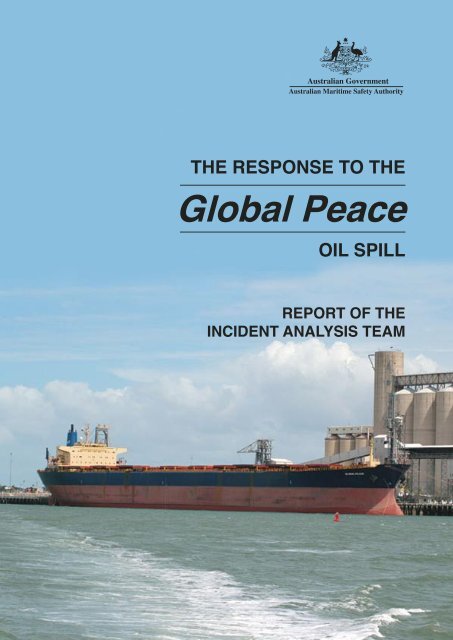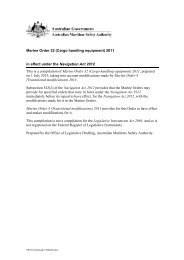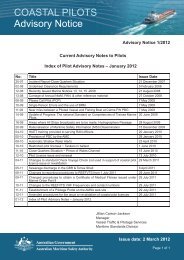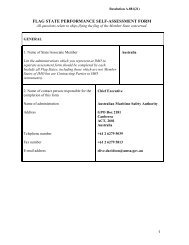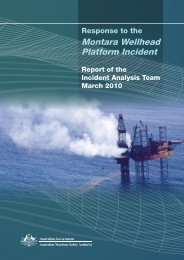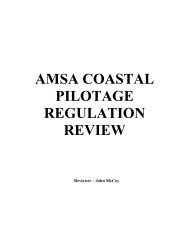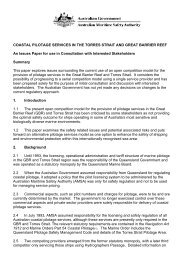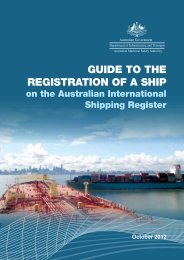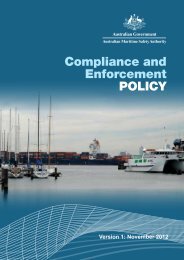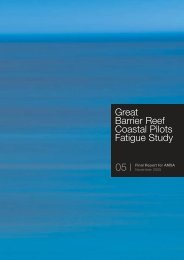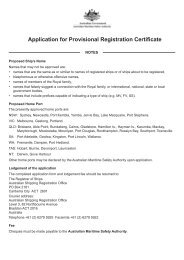Global Peace - Australian Maritime Safety Authority
Global Peace - Australian Maritime Safety Authority
Global Peace - Australian Maritime Safety Authority
You also want an ePaper? Increase the reach of your titles
YUMPU automatically turns print PDFs into web optimized ePapers that Google loves.
<strong>Global</strong> <strong>Peace</strong> - Incident Analysis Team ReportRESPONSE TO THE GLOBAL PEACEOIL SPILLREPORT OF THE INCIDENT ANALYSIS TEAMSEPTEMBER 2006Report by the Incident Analysis Team into the Response by the NationalPlan to Combat Pollution of the Sea by Oil and Other Noxious andHazardous Substances, to the Oil Spill from the <strong>Global</strong> <strong>Peace</strong> in Gladstoneon 24 January 2006.i
<strong>Global</strong> <strong>Peace</strong> - Incident Analysis Team ReportCONTENTSPrefaceExecutive Summaryiiiiv1. Incident Description 12. The Response 43. Planning 74. Personnel and Equipment 95. Adequacy and Effectiveness of Wildlife Rescue and Rehabilitation 126. Environmental Advice and Support 137. Occupational Health and <strong>Safety</strong> Issues 158. Administration Support Services 179. Relationships Amongst Parties Involved in the Response 1910. Contingency Plans – National, State and Local 2211. Recommendations 2312. References 25Appendix 1 – Terms of Reference 26ii
<strong>Global</strong> <strong>Peace</strong> - Incident Analysis Team ReportPREFACEFollowing the <strong>Global</strong> <strong>Peace</strong> oil spill in Gladstone on 24 January 2006, two separate inquirieswere undertaken to investigate the circumstances surrounding the cause of, and response tothe oil spill.The first inquiry, undertaken by the <strong>Australian</strong> Transport <strong>Safety</strong> Bureau (ATSB), wasestablished under the provisions of the Transport <strong>Safety</strong> Investigation Act 2003. The purposeof the ATSB inquiry was to identify the factors contributing to the incident so as to assist inpreventing similar incidents in the future.The second inquiry, the subject of this Report, was established by the <strong>Australian</strong> <strong>Maritime</strong><strong>Safety</strong> <strong>Authority</strong> (AMSA) and <strong>Maritime</strong> <strong>Safety</strong> Queensland (MSQ) under the auspices of theNational Plan Management Committee and the National Plan to Combat Pollution of theSea by Oil and Other Noxious and Hazardous Substances (the National Plan).An Incident Analysis Team (IAT) was established in February 2006 to undertake acomprehensive analysis of the management of the incident from an oil spill responseperspective, to assess the adequacy of the response and identify any lessons that couldbe learnt by <strong>Australian</strong> spill responders. The terms of reference for the incident analysis,including details of the Team’s membership are at Appendix 1.IAT members attended key debriefing sessions of the main organisations involved with theresponse, conducted personal interviews and discussions with many of the people involvedwith the response ranging from State level management through to on ground respondersas well as with community and environmental groups.The IAT has identified a number of issues that were raised either during or after theresponse. Each issue has been examined in detail using a range of available informationsources to ascertain its veracity. Based on this examination a series of conclusions andrecommendations are presented.The open response of the many individuals and organisations that provided writteninformation and made time available for interviews and discussion is greatly appreciatedby the IAT.Any comments or criticisms in the Report must be read in a constructive sense. As with anyanalysis of an emergency incident it is important to ensure that the lessons learnt are usedto improve arrangements and preparedness in readiness for any future incidents.Captain Charles BlackChair, Incident Analysis Team29 September 2006iii
<strong>Global</strong> <strong>Peace</strong> - Incident Analysis Team ReportExecutive SummaryFollowing the <strong>Global</strong> <strong>Peace</strong> oil spill in Gladstoneon Tuesday 24 January 2006 an analysis wasundertaken to examine the effectiveness of theresponse to the spill. The <strong>Australian</strong> <strong>Maritime</strong><strong>Safety</strong> <strong>Authority</strong> (AMSA) and <strong>Maritime</strong> <strong>Safety</strong>Queensland (MSQ) established the investigationjointly under the auspices of the National PlanManagement Committee (NPMC) and theNational Plan to Combat Pollution of the Sea byOil and Other Noxious and Hazardous Substances(the National Plan).The IAT found that overall a good outcome wasobtained in cleaning up the <strong>Global</strong> <strong>Peace</strong> spill. Theresponse was effective with some 18 tonnes of25 tonnes of oil recovered within five days andminimal environmental damage to Gladstoneharbour and the surrounding environs. Thisis a testament to the success of the operation.The Gladstone harbour, foreshores, marina andaccessible surrounding mangroves were cleanedas far as practicable. The oil that could not beremoved has degraded over time and is expectedto continue to do so.The Port Curtis Integrated Monitoring Program,established under the auspices of the Universityof Central Queensland to monitor Gladstoneindustry’s environmental effects on the marineenvironment, is well positioned to monitor anylonger-term effect of the spill.While in hindsight some response decisionscould be questioned by the IAT, at the time oftheir making there was a clear process in place.However, the IAT has identified a number ofsystemic problems. While these problems did notmaterially affect the overall outcome, they didcontribute to making the response more difficult.Like all oil spill response scenarios, the IATbelieves there are lessons that can be learnt fromthis incident and areas where improvements canbe made in order to enhance any future responses.Fourteen recommendations have been made,mostly of an operational nature. It needs to beemphasised that the majority of the issues givingrise to the recommendations may have impactedon the effectiveness and efficiency of the activities,however they did not materially affect the overalloutcome of the response. There is concern by theIAT that unless these issues are addressed theycould have a serious impact in a more complex orlarger spill.While the recommendations address a range ofissues, the IAT has identified 4 key strategic areaswarranting further consideration by the NationalPlan Management Committee/National PlanOperations Group.Firstly, the application of the Oil Spill ResponseIncident Control System (OSRICS). The IATbelieves that the flexibility and the utility of theOSRICS structure was not fully appreciated andapplied to its full advantage during the responseand this tended to create a number of problems initself.Secondly, Occupational Health and <strong>Safety</strong>(OH&S). While a reasonable OH&S outcome wasachieved, it appeared more attributable to thecommitment and experience of individuals ratherthan a well constructed and promulgated strategy.Thirdly, media and communications. The spillcreated a good deal of media interest both locallyand internationally. However, the timing of thespill just prior to Australia Day and the vacuumcreated by the lack of timely, factual and accurateinformation provided to the media, caused themto develop their own headlines and stories greatlyexacerbating the actual size, extent and impact ofthe spill.Finally, the IAT is particularly concerned aboutthe manner in which the dispersant testingeffectiveness was undertaken, the conclusionsdrawn and as a consequence the reductionin response options available to the IncidentController.iv
1INCIDENT DESCRIPTION<strong>Global</strong> <strong>Peace</strong> - Incident Analysis Team ReportOn Tuesday 24 January 2006, at about 2354, thetug Tom Tough experienced engine problemsand landed heavily against the port side of thePanamanian registered bulk carrier <strong>Global</strong> <strong>Peace</strong>(132,049 DWT – built 1982). The incident occurredduring a berthing operation at the Clinton Wharfcoal terminal facility in the port of Gladstone,Queensland.The impact breached the ship’s hull and ruptureda port side fuel tank. Heavy fuel oil flowed intoGladstone harbour from the hole in the ship’s sidefor about 45 minutes. At the time of the incident,the vessel’s port side fuel tank contained about150 tonnes of heavy fuel oil. An amount of heavyfuel oil, later confirmed by an independent bunkersurvey to be 24.53 tonnes was lost into the harbouron the flood tide. No injuries to personnel oneither the ship or the tug were reported.The Port of Gladstone and surrounding areascontain a number of diverse environments, someof which are highly sensitive to the effects ofmarine pollution. These include large areas ofmangroves, intertidal mudflats and seagrass bedsclose to the shipping channel and port area. Themarine environment around Gladstone is alsodocumented as a habitat for seabirds and wadersas well as for turtles, dolphins and dugong. Thearea is also important for the prawn and fishingindustries.The Gladstone Marina, Auckland Creek andBarney Point beach, as well as the islands withinthe harbour, are important recreational areas forthe local community.At 2357, pollution response personnel in the portwere notified and the Port of Gladstone’s FirstStrike Oil Spill Response Plan was activated.MSQ assumed statutory and combat agencyresponsibility almost immediately. The IncidentControl Centre (ICC) was setup in the MSQoffices in Gladstone during the early morning ofWednesday 25 January.The Incident Controller made an initial fielddecision based on personal observations thatdue to OH&S considerations no equipmentdeployment would be undertaken during thehours of darkness.To augment local resources, a range of spillresponse equipment was prepared through thenight for deployment at first light about 0530 onWednesday 25 January. These resources weredrawn from the major stockpiles in Brisbane andTownsville and included four Marco oil recoveryvessels from Townsville, Mackay, Gladstone andBrisbane. AMSA, as manager of the NationalPlan, assisted with mobilising equipment andpersonnel to support the clean-up effort.An overflight was carried out at 0530 to determinethe extent of the oil impacted area and supportdetailed planning to respond to the incident. Anamount of heavy fuel oil was observed in themain channels and waterways system extendingfrom east of Barney Point to Black Swan Island atthe start of The Narrows. Heavy oiling was alsoobserved along the banks and mangroves in theCalliope River (Map 1, refers).A second overflight was carried out at 0900 andtwice daily thereafter. The information gainedfrom the overflights was critical in planning theresponse to the incident. By the end of Day 1,response equipment both local and intrastatehad arrived and been deployed to facilitatecontainment and recovery. Given the inherentgeographical challenges, this was a good result.Early in the morning of Wednesday 25 Januarya decision was made to boom off the mouth ofAuckland Creek with boom that was stored at,and hence readily available in, Gladstone.Calliope River first FlyoverWednesday 25 January at 05:301
<strong>Global</strong> <strong>Peace</strong> - Incident Analysis Team ReportThe rationale behind this booming was to preventoil from entering both the Marina and the powerstation cooling intake by deflecting any slick awayfrom the creek entrance.Around this time a decision was also made toclose the Marina to all vessel traffic. The closurelimited access and egress by a range of vesselsincluding commercial tourism and fishing vessels.However, later the boom was opened to allow theHeron Island ferry, two lines launches and thepilot launch to depart and it was at this time thatoil first entered the Marina. This resulted in a newclean-up area being created in the Marina’s fingerberths and the associated oiling of moored vessel’shulls.There was also a need to relocate thedisembarkation point for the Heron Island ferryto one of the Port’s main commercial wharves,which presented a range of issues for theCentral Queensland Port <strong>Authority</strong> (CQPA) andpassengers.Commercial fishers were also subject to a rangeof disruptions including possible loss or taintingof product, closure of the local fisheries andsubsequent loss of market access and hence anaffect on income. As a result of a lack of factualinformation on the possible effect of oil on themarine environment and fish stocks, the localcommercial fishers interacted with the media in aneffort to highlight their concerns.As part of the response, dispersant effectivenesstesting was undertaken on the morning ofWednesday 25 January. Based on the outcome ofthis testing, the Incident Controller was advisedthat the various National Plan dispersants werenot an effective response option to the spill. Thislimited the range of available response options forthe Incident Controller. While there was a lack ofhelicopter dispersant capacity in Gladstone, boatmounted equipment for dispersant applicationwas available as was access to the National Plan’sfixed wing aerial dispersant capability.Gladstone City Council was advised by MSQon the first day of the incident. However,despite having a range of equipment that wouldhave been appropriate to use in shorelineclean-up operations they were reluctant toprovide assistance, as they were unsure of theirresponsibility in this regard.P&I Club representatives were on site during thespill response. A bond of A$5 million was soughtand obtained by MSQ from the P&I Club to covera range of costs associated with the response.While the issue of the bond was handledfairly well between MSQ and the P&I Club,there were some problems with ambit claims,difficulties in contacting the P&I Club and/ortheir local representatives by public stakeholders,uncertainty about the claims process, and theoperation of the P&I Clubs and third party claimsgenerally.Over the next six days, personnel and equipmentwere deployed to undertake shoreline assessment,clean-up the spill and respond to oiled wildlife.The on-water recovery operations were completedby 28 January, with the relevant equipment beingreturned to the stores. The shoreline clean-upwas completed to the standards required by theQueensland Environment Protection Agency(QEPA) by 30 January.Fortuitously, in 2001, the Port Curtis IntegratedMonitoring Program (PCIMP) which is aconsortium of 14 bodies representing industry,government (both local and State), researchinstitutions and other stakeholders wasestablished to develop a cooperative monitoringprogram for assessing the ecosystem health of PortCurtis (including Gladstone harbour).PCIMP recognised that an assessment of the effectof the <strong>Global</strong> <strong>Peace</strong> spill was required as soon aspossible in order to separate the effects of the spillon the marine environment from those generalconditions causing changes in the harbour.At this stage, PCIMP’s initial assessment indicatesthat residual oil deposits have affected less than1 per cent of the harbour. This assessment willbe followed up by 6 and 12-month assessmentswith annual monitoring continuing thereafter.The University of Central Queensland has alsoestimated that the spill affected 1.5ha or 0.02 percent of the total mangrove area in Port Curtis (F.Melville, pers. comm., 2006).2
<strong>Global</strong> <strong>Peace</strong> - Incident Analysis Team ReportMap 1 - Extent of oil (1 st Flyover)3
<strong>Global</strong> <strong>Peace</strong> - Incident Analysis Team Report2THE RESPONSE(a) Issue: Call Out ArrangementsBackgroundConcern was expressed during the debriefs thatthe call out arrangements had not functioned aseffectively as expected. This was attributed tothe increased use of mobile phones rather thanlandlines. For a callout arrangement based onmobile phones to be effective, procedures mustensure that on call personnel have their phoneswitched on and available i.e. not switchedthrough to message bank.There was also a minor issue with the mobilephone provider’s settings in which calls thatwere not responded to within 3 rings wereautomatically switched through to message bank.ConclusionThis issue does not appear to have been asignificant concern. At the local level, theGladstone call out arrangements worked wellthough there is always the need to review andupdate telephone contact lists.Whilst there may have been a few calls to themessage banks of Brisbane based personnel therewas no direct impact either on the response or thearrival of additional responders and equipment.have escaped. The tug’s three-man crew werefully engaged in managing on board problems,while the lines’ boats personnel continued theirassistance in berthing the vessel.None of the three vessels involved carried anyspill response equipment on board other thanfor their own immediate needs. It was felt thatthe suggestion, that ‘jury rigging’ a device totemporarily stem the flow of oil, warrantedfurther consideration by the IAT. The IAT tookthe following view: that as oil is a hydrocarbonbased chemical substance, it should only behandled directly by humans using protectiveapparel. While a plugging arrangement mayhave been successful, the lack of appropriatepersonal protective equipment (PPE), an oily deck(that is an inherently unsafe work environment),inadequate lighting and a lack of equipment onboard to plug a hole, would mitigate any suchapproach.ConclusionIn considering this issue, the IAT is satisfied therewas nothing that the vessel’s crew, the lines boats’or tug’s personnel could have done to temporarilyprevent or stem the flow of oil escaping from thevessel.(b) Issue: Response Actions by the Vessel’sCrew, Lines Boats’ and Tug’s PersonnelBackgroundDuring the course of the interviews a number ofparties suggested that the vessel’s crew, lines boats’and tug’s personnel might have been well placedto provide an immediate response to the spill byeither utilising available response equipment onboard the respective vessels or by ‘jury rigging’ adevice to temporarily stem the flow of oil.Following an assessment, it is the IAT’s view thatthe vessel’s crew could not have mounted animmediate clean-up response as they were stillengaged in the berthing of the ship. However, thecrew did immediately commence transferring oilfrom the ruptured tank, which had the effect ofreducing the volume of oil that potentially could(c) Issue: Booming of Auckland CreekBackgroundAlthough booms were deployed at the entrance toAuckland Creek/Marina, oil entered both areas.There was a diversity of opinion at the debriefsand interviews as to whether the method ofbooming Auckland Creek was an effectiveresponse measure.Early in the morning of 25 January a decision wasmade to boom off the mouth of Auckland Creekwith boom that was stored at, and hence readilyavailable in, Gladstone. The rationale behind thisbooming was to prevent oil from entering both theMarina and the power station cooling intake bydeflecting any slick away from the Creek mouth.Although the boom was initially set up fordeflection it in fact worked well for a short period4
<strong>Global</strong> <strong>Peace</strong> - Incident Analysis Team Reportof time in containment mode. However, it provedto be ineffective due to the boom being placed:• across the Creeks’ mouth which was effectivelyacross the current;• at a different location from that previouslyidentified and used in MSQ training exercisesundertaken by local MSQ and CQPA responderstaff;• without any apparent calculation of its’ loadingcapacity. Ultimately the boom broke as a resultof some uncertain factor – meteorological,tide/current, fishing vessel, etc; and,• without any marking or monitoring overnight.ConclusionIn summary, the booming of Auckland Creekand the method in which it was done was not awell-conceived idea and had it been handled in amanner identified in previous training exercises,a number of problems that occurred later in theresponse could possibly have been avoided.A further compounding element to this issuewas the opening of the boom. The boom wasopened twice. Firstly, to allow a number ofcommercial vessels to depart from the Marina andthis resulted in no ingress of oil. The second, 50minutes later allowed oil to enter the Marina andcaused recurrent clean-up problems for responsestaff in dealing with a range of recreational andcommercial vessels moored in the Marina.There is need to ensure that the National Plan’scompetency based training modules on the useof oil spill containment booms for respondersemphasizes the limitations of booms in tidal areasand where currents of greater than 1 knot areexperienced. In particular, the following pointsneed to be noted:• adequate securing arrangements and loadcalculations;• an understanding of deflection andcontainment modes;• appropriate marking and monitoring; and,• recognition and utilisation of responderknowledge gained through on ground trainingexercises.(d) Issue: Marina ClosureBackgroundWhile the effectiveness of the booming ofAuckland Creek is discussed above the closureof the Marina proved to be a good preventativemeasure but was subsequently negated by adecision to open the boom.The boom was opened twice. Firstly, to allowthe Heron Island ferry, two lines launches andthe pilot launch to depart. A second opening,50 minutes later, allowed oil to enter AucklandCreek and the Marina. The outcome of this actionwas that a new clean-up area was created in theMarina’s finger berths and the associated oiling ofmoored vessel’s hulls.It should be noted that closure of the Marinalimited access and egress by a range of vesselsincluding commercial, tourism and fishing vessels.There was a need to relocate the disembarkationpoint for the Heron Island ferry to one of thePort’s main commercial wharves, which presenteda range of issues for CQPA and passengers.Commercial fishers were also subject to a range ofdisruptions including possible loss or tainting ofproduct, market uncertainty and hence an affecton income.ConclusionThe IAT believes that the decision to close theMarina proved to be a worthwhile responsemeasure and whilst it could have been doneearlier the essential lesson to learn is that once thedecision had been made it should have remainedclosed until the potential for the ingress of oil intothe area had ceased.(e) Issue: Uncertainty in Reporting Size of SpillBackgroundVarying estimates of the spill size were reportedduring the initial stage of the response. Figuresranging from 3 to 150 tonnes were provided froma range of sources. Uncertainty over the quantityof the spill prevailed for some time and whilst thisdid not appear to affect the overall response it didhave implications initially in terms of effectiveresponse planning.5
<strong>Global</strong> <strong>Peace</strong> - Incident Analysis Team ReportInitially the Master believed that three tonnes ofoil had escaped from the vessel. A surveyor’sreport requested by the Incident Controllerfrom the ship’s agent on Wednesday 25 Januaryrevealed a more accurate estimate of 24.53 tonnes.ConclusionWhilst there was an initial problem that couldimpact on response planning, personneldeployment and equipment mobilisation, thereis probably little that can be done to improvethe situation. Clearly though from a mediaperspective, an accurate estimate of the spill size iscritical, before an official figure is reported.(f) Issue: Security and AccessBackgroundThere was a need to relocate the disembarkationpoint for the Heron Island ferry to one of thePort’s main commercial wharves, which presentedsome issues for the CQPA including the need toaddress security and passenger access.Whilst maritime security and port access in termsof the Commonwealth’s <strong>Maritime</strong> Transport andOffshore Facilities Security Act 2003 was a minorissue in this incident, response personnel notedan inconsistent approach to security and accessat a range of venues during the response. Forexample, during the interviews it was stated thatnormal security procedures were periodicallyrelaxed at the ICC and this could have alloweduncontrolled access to the response’s mainplanning area.ConclusionThe IAT believes that this was only a minorissue during this incident and did not materiallyimpact upon the response. However, all agenciesshould retain as a minimum their normal securitystandards and procedures during an incidentresponse.6
<strong>Global</strong> <strong>Peace</strong> - Incident Analysis Team Report3PLANNING(a) Issue: Incident Response PlanningBackgroundIncident response planning consists of twointegral components: pre-incident planning andresponse planning.The IAT believes that there were deficiencies inboth the pre-incident and incident planning thatshould be recognised and considered prior to anyfuture spill response.In terms of pre-incident planning, MSQ and CQPAstaff had identified and trialled deployment ofequipment at sites likely to be most effective inresponding to a spill of this type. Whilst someresponse staff were aware of these operationalissues they had not been formally documentedin the contingency plan or elsewhere for futurereference.Response planning appeared to have beenundertaken on an emergency basis only, withoutfull consideration of future events and theirimplications. When for example the decision toclose the Marina was made, little considerationappears to have been given to the flow on effectsto commercial vessel operations includingcharter and fishing vessels and the lines and pilotlaunches.The formation of the planning group did notseem to follow the OSRICS structure or principlesand resulted in an incomplete group that couldhave played a more effective part in the overallresponse.The expertise that NRT members could bringto the response (equipment, logistics, finance,administration, environmental, aerial surveillance)was not fully investigated nor appreciated bymanagement and this resulted in the less thanoptimal utilisation of personnel and their skills.Ten NRT members arrived on scene and werenot briefed at the time. Rather they were briefedthe following day resulting in delays in theiravailability for response activities.ConclusionAs planning is an essential element of any spillresponse an effective structure and system asoutlined in OSRICS needs to be in place at an earlystage to ensure immediate and ongoing issues arecaptured and addressed.Pre-incident planing needs to be enhanced usingexperienced gained from exercises, trainingand specific potential scenario evaluations andcontingency plans updated accordingly.Finally, NRT requirements should be identifiedearly in a response by the Incident Controller andclearly conveyed to AMSA and that more effectiveand efficient use of the NRT’s expertise be madeduring a responseRecommendationsThe IAT recommends that an assessment regime isintroduced for Incident Controller courses (i.e. theOil Spill Management Course) and that IncidentControllers or their equivalents undergo retrainingand revalidation at least every five years withAMSA to maintain the records and advise theIncident Controllers accordingly.(b) Issue: LogisticsBackgroundDuring debrief and interviews the IAT receivedfeedback that highlighted failures in the timelysupply and quality of resources during theresponse by a range of agencies.Whilst responsibility for logistics in the IncidentManagement Team was allocated to an individualthis was never their primary task and this resultedin a lack of focus on the supply and distributionof resources required for an effective and efficientresponse. This was clearly demonstrated in thearea of catering where quality and quantity ofsupplied provisions was often subject to criticism.Anecdotal advice suggests that the use of asingle level of authorisation for expenditure may7
<strong>Global</strong> <strong>Peace</strong> - Incident Analysis Team Reporthave led to some delays in provisioning and thisfunction could have been delegated to a range ofappropriate staff.In term of pre-incident planning, the lack ofidentification of suitable suppliers and agenciesto provide resources and provisions during anincident in suitable quantities created unnecessarydifficulties.ConclusionNotwithstanding that the clean-up was successful,the response was compromised by a lack ofunderstanding and resourcing for logistics andexpenditure authorisation levels which couldpotentially have affected the welfare and safety ofresponders.During a response, logistics needs to be betterrecognised and resourced, as it is a separatespecialist area in response planning underOSRICS. To this end, future desktop exercisesshould ensure that logistics are better resourcedand that requests are clearly identified andactually followed through. The use of a singlelevel of authorisation for expenditure during aspill response should be avoided and appropriatedelegation arrangements put in place.8
<strong>Global</strong> <strong>Peace</strong> - Incident Analysis Team ReportTemperature is an important parameteraffecting the viscosity and Gladstone’s seawatertemperature in January/February can reach up to27 o C.The widespread dispersion of the oil as attestedto by its rapid tidal current induced distributionthroughout Gladstone harbour and thesurrounding marine environs would suggest thatthe selective use of dispersants may still have beenan appropriate response tool.However, this is only one consideration as thereare other secondary benefits available withdispersant use. In particular, the Nat-DET Kitoperator needs to also consider how the oil’sproperties are changed with the application ofdispersants. For example, oil may become `lesssticky’ following dispersant application andthis will assist mangroves in self-cleaning andrecovering from the effects of a spill throughnatural tidal flushing.It is generally accepted that dispersant use oversensitive seagrass beds should be avoided.However, this does not, and should not, precludeits selective use in or near tropical mangroveareas.Mangrove environments are particularlysusceptible to the effects of oil as a result of theirexposed root systems, the adherence of oil to trees,the entry of oil into the underlying mud matrixand its repeated release from this matrix andsubsequent tidal inundation of mud flats.Previous National Plan funded long-term researchwithin the Gladstone port area has shownthat using an oil/dispersant mix enhances theability for mangroves to naturally self clean andminimises the environmental impact of oil spills.An alternate view suggests that there maybeproblems with dispersant use in that it canfunction as a defoliant when sprayed directly ontomangroves and may cause additional problemswith increased chemical load on the environment.ConclusionThe IAT is particularly concerned aboutthe manner in which the dispersant testingeffectiveness was undertaken, the conclusionsdrawn and as a consequence, the reductionin response options available to the IncidentController.Failure to use the Nat-DET Kit relying insteadon the `Coke bottle’ approach by personneluntrained in the equipment and techniques servesonly to severely undermine the reliability of anyconclusions drawn. This could be overcomeif training in the use of the Nat-DET Test Kitis brought within the ambit of the enhancedNational Plan training program relying as it doeson the application of competency based trainingprinciples.RecommendationsThe IAT recommends the Environment andScientific Coordinator (ESC) or their equivalents,using the National Plan Dispersant EffectivenessTest Kit, undertake responsibility for dispersanttesting effectiveness during a spill response andthat this is clearly identified in contingency plans.(c) Issue: Equipment Deployment at NightBackgroundThe Incident Controller made a field decisionbased on personal observations that due to OH&Sconsiderations no equipment deployment wouldbe undertaken during the hours of darkness.During the debrief and interviews some personneland stakeholder groups questioned this decisionbased on their operational experience in relatedmaritime industries. It was suggested that withadequate lighting and appropriate equipment animmediate response could be mounted during thehours of darkness.10
<strong>Global</strong> <strong>Peace</strong> - Incident Analysis Team ReportConclusionThe IAT noted that responding agencies gavecareful consideration to deployment of equipmentat night and decided that:• normally response equipment deploymentat night is not undertaken for a range ofreasons largely centred on OH&S. In somecircumstances it can be done. For instance,during the Laura D’Amato response at GoreBay in Sydney Harbour, personnel successfullydeployed boom during the hours of darkness.This was a well practiced activity attachingbooms to defined anchorages, conducted inpartial light by experienced crews;• there were substantial OH&S issues withdeploying equipment at night particularlywith respect to wet, slippery and potentially oilcovered rocks, the difficulty in distinguishingbetween oil and water under low lightconditions and consideration of sea swell, tidaland current flows; and,• no pre-existing anchor points were available inthis location.This approach is reinforced in paragraph 3.1 ofthe Queensland Coastal Contingency Action Planwhere the preservation of human life and safetyis identified as the number one priority during aspill response.The IAT did not accept that a range of spillresponse equipment could be operated safelyand effectively at night. Further, the IAT did notaccept comparisons with operational experiencesin related maritime industries.(d) Issue: Equipment MarkingBackgroundDuring the debriefs and the interviews it wassuggested that response equipment needed tobe better labelled and marked to assist in fieldidentification using some form of colour codingto indicate point of origin and/or ownership. Itwould also assist in record keeping. It was alsosuggested that a laminated contents list should beincluded inside National Plan field kits.ConclusionThe IAT agreed with these observations, andwere aware that a standard numbering systemis already used by AMSA and the <strong>Australian</strong>Marine Oil Spill Centre (AMOSC) to identifyequipment. Information on the existing standardequipment identification system and a commonequipment marking protocol should form part ofEquipment Operators Courses and that a referenceto the system needs to be made in other relevantNational Plan training courses.RecommendationThe IAT recommends that a common equipmentmarking protocol for National Plan participants beestablished.11
<strong>Global</strong> <strong>Peace</strong> - Incident Analysis Team Report5ADEQUACY AND EFFECTIVENESS OFWILDLIFE RESCUE AND REHABILITATIONIssue: Adequacy and Effectiveness of WildlifeRescue and RehabilitationBackgroundGiven the limited wildlife rescue andrehabilitation associated with this incident therewas no real effectiveness testing of this responsecomponent. Appropriate equipment and responsepersonnel were deployed, but the small numberof impacted wildlife, less than 10 birds, meant thatthe response was completed in a relatively shortperiod of time with all personnel being stooddown after six days.Queensland Parks and Wildlife Service (QPWS)reported that there were some minor problemswith the local oiled wildlife response plan notbeing regularly updated to reflect changesin personnel, contacts details and availableequipment.During the response, two pods of marinemammals were monitored. A pod of dolphinsnear the Marina moved away during the incidentand subsequently returned. While another pod,located in the Calliope River, seemed unaffectedby the spill.QPWS received reports of two dead dugongssome three to four weeks after the oil spill. Whileno oil was reported in the gut or intestines of theseanimals, no chemical analysis was undertaken dueto their decayed state.The area is not a bird breeding area so there wereno migratory or intertidal birds in the area duringthe spill.ConclusionThe IAT noted that the staged and structuredapproach adopted by QPWS in establishing awildlife stabilisation centre as an initial step andthen planning for additional actions as and whenrequired, was entirely appropriate. There is also aneed for all response agencies to regularly reviewand update their oiled wildlife response plans.Calliope River12
<strong>Global</strong> <strong>Peace</strong> - Incident Analysis Team Report6ENVIRONMENTAL ADVICE AND SUPPORT(a) Issue: Use and Effectiveness of the Oil SpillResponse Atlas (OSRA)BackgroundThe IAT believes that OSRA was not wellappreciated as a resource in this incident. Instead,reliance was placed on local based knowledge,which while timely, cost effective and accuratewas outside of the OSRA system.The IAT noted that in this instance, environmentalplanning for the <strong>Global</strong> <strong>Peace</strong> response wasprimarily a paper-based exercise. This arose as aresult of:• a strong preference in the ICC for paper basedpresentation of information;• no available trained OSRA operators in the first24-36 hours after the spill;• the use of only one OSRA operator to check,verify, interpret and present information whensuch a range of tasks normally requires twopeople; and,• the belief that the Gladstone OSRA systemwould not interconnect with other computerbased planning and response systems, that itwould not produce up to date maps, that itsinformation was out of date and that it waspreferable to rely on locally based knowledge.ConclusionNotwithstanding a considerable data gatheringexercise in the recent past, the combined benefitof OSRA and local data was not achieved. Thisresulted from a lack of appreciation of the benefitsof a well operated OSRA during a response and alack of preparatory work prior to an incident.OSRA has been designed to provide, in aneffective and efficient manner, rapid access to arange of environmental information for planningwhen responding to a spill. Like any tool it isonly as effective as its operator, the information itcontains and the interpretation of that informationand ultimately the training and competence of theoperator(s).The IAT believes that there is a need for a betterunderstanding of the OSRA system at all levelsthrough a greater emphasis on training and thecollection and input of data and that the skillsets afforded by an OSRA operator should berecognised as a specific element for inclusion inthe NRT.RecommendationThe IAT recommends that AMSA and theStates/NT identify and reconcile any differencesin philosophy or strategy regarding both themaintenance and operation of the OSRA system.(b) Issue: Shoreline AssessmentBackgroundShoreline assessment and subsequent clean-upwas largely effective. However, considerable timewas lost due to inexperienced personnel beingassigned to foreshore assessment and out of dateMOUs with local councils.Whilst CQPA staff believed that they haveresponsibility for shoreline areas to the highwater mark on Port lands, this is neither statedin, nor supported by the Oil Pollution First-StrikeResponse Deed between themselves and MSQ.While the shoreline clean-up was effective andadequately resourced, there were some concernsregarding the safe deployment of staff withparticular reference to adequate supplies ofwater and management of personnel working inconditions of high tropical heat and humidity.There were also some other problems in thatQEPA staff, while well trained in oiled wildliferesponse, were not as familiar in shorelineassessment, in particular clean-up planning andoperations. As a result this necessitated up tothree visits to an area to undertake the requisiteshoreline assessment, planning and clean-up.ConclusionThe IAT believes that, overall the foreshoreassessment and clean-up was largely effective butthere is need to clarify areas of responsibility andjurisdiction between agencies.Further, the IAT believes that shoreline assessmentshould not be the sole responsibility of the ESCbut rather should utilise a multidisciplinarycapability so that environmental, heritage,planning, cultural and operational issues areaddressed at once.13
<strong>Global</strong> <strong>Peace</strong> - Incident Analysis Team ReportRecommendationsThe IAT recommends that training for shorelineassessors be enhanced to develop theirmultidisciplinary capability so as to permitsimultaneous field assessment of environmental,heritage, cultural, planning and operational issues.(c) Issue: Waste ManagementBackgroundThe disposal of waste, while expensive, waseffectively handled through the use of an externalcontractor to remove both solid and liquid wasteas well as undertaking the clean-up of spillresponse equipment.It is worth noting that the licensed waste disposalcompany used in this instance, brought all wasteback to Brisbane for processing.ConclusionThe IAT concluded that the issue of wastemanagement during the response was wellhandled. In particular, the approach of outsourcing its management is one that shouldbe considered along with any other applicablealternatives in future.14
<strong>Global</strong> <strong>Peace</strong> - Incident Analysis Team Report7OCCUPATIONAL HEALTH AND SAFETY ISSUES(a) Issue: OH&SThe IAT has identified a number of differencesand discrepancies between the approach reportedby management and that by field responsepersonnel.Operational planning for OH&S could not bevalidated. Although ICC personnel reportedthat detailed plans had been produced daily andauthorised by the Incident Controller, the actualdocuments could not be produced for review. Therequest to sight the documents resulted from thesubstantial variance in views between the ICC andwork sites.While a reasonable outcome was achieved, itappeared more attributable to the commitmentand experience of individuals rather than a wellconstructed and promulgated strategy.The IAT has identified a number of specificconcerns including:• OH&S roles and responsibilities were notwell defined and therefore there was often nospecific responsible person nominated duringpractical activities;• the overall plan was not well distributed sothere was no consistent standard or obvioussafety leadership;• although MSQ has a published Hours of WorkPolicy, it was not applied consistently duringthe incident;• cost management restraints impacting on anumber of facets of the incident. For example,the provision of water and supplies is essentialto ensure responder safety and morale andcare needs to be taken to ensure that this isdone in a timely manner and without the needto get too high a level of authorisation forexpenditure purposes;• a reliance on responders to self monitor withno formal program to ensure compliance;• no formal check-in or registration of staff; nomeeting of personnel upon arrival in Gladstoneand no staff induction. One on one interviewswith responders indicated that there was alack of process for ensuring that there wasindividual awareness and commitment tosafety;• some reported problems with people not usingPPE, though these issues were never formallyreported to the ICC;• a number of small OH&S incident reports werenot logged with the ICC and there was nooverall incident reporting structure; and,• staff rotation through an incident would reduceburn out/potential OH&S problems andwould also expose more <strong>Australian</strong> responsepersonnel to actual spill incidents.ConclusionThe IAT believes that a reasonable OH&S outcomewas achieved by personnel knowledge andtraining rather than by design. Whilst groupsseemed to work to their own individual OH&Srequirements there was no overall safety planpromulgated or control and coordination ofresponse staff.While response plans can always be reviewedto strengthen their OH&S component, thereare a number of commonsense measures thatagencies can adopt to enhance OH&S during aspill including implementing an hours of workarrangement by identifying a staff rotation policyand adhering to that policy; and, for safetyreasons, providing to each person operating in thefield, a map of the area and a telephone contactlist.RecommendationsThe IAT recommends the National Plan introducea formal safety training program for spillmanagers. The program should comprise desktopexercises and require managers to detail the safetyphilosophy and objectives for a spill response andto design the implementation strategy, showinghow the philosophy would be communicatedthrough the line of command and result inawareness by all personnel of the commitment tosafety. Further, the OH&S component of responsetraining should be reviewed and amended toensure that safety management is a primaryelement in management training.15
<strong>Global</strong> <strong>Peace</strong> - Incident Analysis Team Report(b) Issue: Registration of StaffBackgroundThe IAT has identified that registration of staffwas a problem during the response. There wasno central congregating or staging point. SomeNRT personnel reported to the ICC. Someresponders reported to the MSQ field operationsbase and not to the ICC. In that circumstancethe Incident Controller was by passed oninformation about available personnel and theirskills.The use of a central congregating or staging pointfor personnel and also for equipment registrationwould be a useful and prudent approach. Thiswould allow for the issuing of identificationand security tags for access to port and incidentoperational areas.It was noted that some staff were initially notprovided with a registration sheet, time sheet ordaily log sheet to record their activities. Such asystem was not operated by the QEPA at all.ConclusionThis is a safety and management issue withstrong implications for OH&S, planning andstaff resourcing and should be addressed bythe recommendations outlined in the OH&Scomponent, above.(c) Issue: Planning for On-going ReliefsBackgroundThe IAT noted that there were a number ofminor problems identified with the on-goingrelief of staff during the incident including poortime management of people and reluctance toturn personnel over quickly enough during theresponse. This is always a potential problem,particularly where there is a strong teamcommitment to get the job done. The IAT alsonoted that there was no plan or policy for relievingpeople during the response. Some agenciesinitiated their own actions such as CQPA who sentstaff home on Day one after a 12 hour shift andMSQ who gave time off to their administration staffor allowed them to job share during the response.One on one interviews with responders indicatedthat they should have been grouped into twoshifts: one working in the field and one preparingfor the next day. This is consistent with the aimsof the OSRICS structure.ConclusionWhilst the inadequate planning for on-goingreliefs during the incident did not materialise asa problem, it is worth noting for future referenceand should be addressed by the recommendationsoutlined in the OH&S component, above.16
<strong>Global</strong> <strong>Peace</strong> - Incident Analysis Team Report8ADMINISTRATION SUPPORT SERVICES(a) Issue: Administration Staff TrainingBackgroundThe IAT has identified that the major responseagencies had a problem with administrativesupport in this incident. Staff knew what wasrequired but were under resourced to effectivelyconduct the requisite tasks.While there were no problems in the supportingclaim to the P&I Club, the IAT is concerned thatif the administration function is not undertakenproperly during an incident, there may besubsequent problems in dealing with, andsupporting claims for, recompense. Problemsmay also arise as a result of an inability to checkand verify any expenses or claims submitted bycontractors, suppliers, staff, etc.The National Plan places a high priority ontraining for field operators and responders withlittle focus or available training units developedfor administration and finance.The IAT was particularly impressed, thatfollowing the identification of a deficiency intraining for administration and finance staff,an individual involved with the responsehad subsequently commenced the process ofdeveloping a suitable program for the State.ConclusionThe IAT believes that while there was availableexpertise to undertake the administrative supportfunction, it was not well used nor well supported.RecommendationThe IAT recommends that the States/NTimplement their responsibilities for runningthe Oil Spill Administration Workshops [seeIntergovernmental Agreement (IGA) on theNational Plan, Schedule 2, paragraph 19].(b) Issue: BondBackgroundFollowing an incident, there needs to be areasonable basis for determining the quantum ofany bond that may be sought. The use of ambitclaims, particularly in the media or as a measureto promote the appearance of government action,should not be pursued, as it is unlikely to besupported by the P&I Club.Rather, when seeking a bond, a party’s intentionsand the basis for the amount sought needs tobe clear. The expected claims components for,inter alia, gear, personnel, clean-up, wildliferehabilitation, court imposed fines, etc, should beestimated along with a component for unexpectedclaims amounts such as oil entering a powerstation’s cooling water intake, etc. It is better tofactor in a worst-case scenario and costs whensetting a realistic bond amount.Such an approach, which is open and transparent,is more likely to meet with a favourable responsefrom the P&I Club than an ambit claim.This incident was most likely the first time thatmany public stakeholders had encountered a P&IClub and it was apparent that the claims processfor many in the local community was either notwell understood or well explained.The IAT was made aware that a numberof claimants and potential claimants hadencountered some difficulties in contacting theP&I Club and/or their local representatives.Concern had also been expressed by a numberof claimants and potential claimants that theP&I Club would not pay for hull cleaning andre-application of anti-foulant. However, the P&IClub indicated that claims by commercial andrecreational boat owners were being paid. Claimsfor consequential loss by commercial fishermenwere not being paid as they were outside thescope of the cover provided by the P&I Club andthe Queensland Seafood Industry Association’s(QSIA) call to stop fishing had made such thirdparty claims more difficult.The IAT also noted that the InternationalConvention on Civil Liability for Bunker OilPollution Damage, 2001 (the Bunkers Convention)would cover costs for such incidents and inparticular third party claims when it enters intoforce both internationally and for Australia.ConclusionThe IAT believes that the issue of the bond washandled fairly well between MSQ and the P&IClub though there were some problems with17
<strong>Global</strong> <strong>Peace</strong> - Incident Analysis Team Reportambit claims, some difficulties in contacting theP&I Club and/or their local representatives bypublic stakeholders and uncertainty about theoperation of the P&I Clubs, the claims process,and third party claims generally.As a result of the incident there is some basis todevelop a plain English standard national bondand undertaking agreement and a standard releaseform or pro forma for vessels. The IAT believes thatguidance on arranging and coordinating bondsand guarantees should be included in contingencyplans.RecommendationsThe IAT recommends that a standard plain englishform of words for bonds and agreements bedeveloped. This should be accompanied by anexplanatory note outlining the legislative basisfor applying bonds, the basis for their calculation,a list of standard claims components that a bondshould cover as well as examples of non-standardclaims components that may be encountered. Aswell as a standard release form or pro forma forvessels should be developed.(c) Issue: Message from Air-Sea RescueBackgroundThe Gladstone Volunteer Marine Rescue (GVMR)was contacted by Gladstone Harbour Control(GHC) on behalf of the ICC and advised thatthere had been an oil spill. They were verballyrequested to broadcast a message to marinersadvising that Auckland Creek and the Marinawere closed to all vessel traffic.The GVMR requested that GHC provide a writtennotice for their use. However, as no written noticewas provided GVMR drafted and broadcastthe message that was requested of them. Thisapparently caused some confusion with marinersas to whether Auckland Creek and the Marinawere open or closed.GVMR also placed personnel at the launchingramps advising mariners of the spill andconsequent restrictions.The IAT noted that there is a local agreement thatGHC usually broadcasts to commercial vesselswhile GVMR broadcasts to the general public.However, GHC does have the capacity to, anddoes broadcast notices to, mariners from 1700 to0500 when GVMR is closed.ConclusionThe IAT noted that although this did cause someconfusion it did not materially impact on theresponse. The IAT is concerned that the release ofinformation needs to be well handled during anincident response. Accordingly, contingency plansneed to provide for the use of specific writteninstructions of required actions when utilisingthe services of any volunteer organisation so as toensure certainty and to reduce the likelihood oferror or confusion.18
<strong>Global</strong> <strong>Peace</strong> - Incident Analysis Team Report9RELATIONSHIPS AMONGST PARTIES INVOLVED IN THE RESPONSE(a) Issue: Media and General Communicationsto StakeholdersBackgroundA number of issues arose regarding media andcommunication as a result of the requirement bythe Minister’s office to approve all material priorto its release to the media. This caused somefrustration at a local level due to the lack ofinformation on spill response clean-up measuresand what affect the spill may have on localfisheries, commercial fishing operators and therecreational boating community.It is a generally accepted practice that the earlyrelease of factual information to the media andstakeholders is a crucial component of anyresponse. However, MSQ are required to followdepartmental policy and guidelines on any mediareleases.In this instance, the vacuum created by the lack oftimely, factual and accurate information providedto the media caused them to develop their ownheadlines and stories greatly exacerbating theactual size, extent and impact of the spill. Allparties recognised that this was a major problemparticularly in Gladstone. In this instance, localmedia and stakeholders were aware there wasa problem but were not being provided factualinformation by either MSQ or the Minister’s office.Whilst the Incident Controller was in regularcontact with a Gladstone City Councilrepresentative, the Council commented on the lackof available information and the frustrating effectit had on both the local community and theirdesire to assist.AMSA also received many media inquiries and ittook several days before a specific media hotlinenumber was provided for inquiries. This shouldhave been done from the outset and been widelydisseminated. As well, agencies should havebeen provided with relevant factual and accurateinformation about the incident on a regular basis toensure there was a consistent response to the media.During the response MSQ were required todirect all media communications through theQueensland Department of Transport’s (QDOT)media communications unit. There also appearedto be no overall coordination of media acrossQueensland government agencies even thoughthere was an agreed arrangement in place betweenagencies on dealing with the media during anincident. This was particularly so in relation tothe issue of fisheries in which the QueenslandDepartment of Primary Industries (QDPI), amember of the Queensland State Committee, actedindependently, handling media matters throughQueensland Health rather than through the agreedarrangement.The IAT also noted that on ground responderswere put in the awkward position of dealing withquestions from the general public without anypublic relations support, appropriate briefing onwhat to do or what factual information to pass on.The IAT also noted that during the response,media staff were also required to participate ina public forum without the requisite technicalknowledge and practical understanding of a spillresponse.ConclusionThe IAT noted that there were a number of majorproblems with media and communications in thisincident. In particular, issues arose through:• the lack of timely, factual and accurateinformation provided to local stakeholders andthe media;• coordination problems between differentgovernment agencies; and,• lack of prior approval from the Minister’s officefor the release of timely, factual and accurateinformation.The IAT noted that while the media andcommunications problems did not materiallyaffect the response, they did contribute to makingthe response more difficult.The IAT believes that response agencies shouldinstitute a priori arrangements with theirMinister’s office to ensure the release of timely,factual and accurate information to both the mediaand local stakeholders during a spill response.RecommendationsThe IAT recommends response agencies utilisetheir own media liaison unit or other suitablearrangements to ensure a coordinated preparationand distribution of media information across allresponding agencies during a spill response.19
<strong>Global</strong> <strong>Peace</strong> - Incident Analysis Team Report(b) Issue: Relationship Between StateGovernment AgenciesBackgroundThe IAT believes that there were somecommunications problems between the Gladstoneand Brisbane offices of a number of governmentagencies that operated independently of theOSRICS response structure.Similarly, the IAT is also concerned about the lackof coordination and the roles and responsibilitiesof a number of State agencies during the response.For example, in responding to fisheries issuesduring the incident, QDPI believed that the matterwas primarily a contaminated seafood issuerather than one relating to the understandingby, and operations of the local fishing industry.This disconnection caused significant unrestamongst the local fishing community that led to aperception, in some cases that the response was notwell managed. Early involvement of an agencycould be assisted by the use of a spill or issueshotline number similar to that used by QEPA.Coordination and exchange of information acrossGovernment agencies is a key action during aspill response. The IAT noted that there was noQueensland State Committee meeting during theincident response and this may have contributedto some of the cross-agency problems encounteredduring the response. Instead, all State Committeemembers were notified of the incident and advisedto be on standby for immediate input. Regularinput was sought from State Committee members.The IAT believes that it is important theQueensland State Committee members representtheir respective organisations and interests in aproactive manner. This will assist in improvingcooperation and coordination during a response.A number of comments were received by the IATthat highlighted the need for better awarenessof, and coordination of, responding agencies atthe local level during a response. In particular anumber of concerns were raised about agenciesacting independently of the Incident Controllerand without any proper technical assessment ofthe situation and its potential risks.ConclusionAs a result of the apparent disconnect betweensome government agencies and the need for abetter coordinated response the IAT believesthere is a need to review participation in theQueensland State Committee with respectto membership, roles and responsibilities ofmembers and the seniority level at which anagency is represented.RecommendationsThe IAT recommends MSQ reviews themembership of the Queensland State Committee,members’ roles and responsibilities and theseniority level at which an agency is representedso as to ensure an enhanced operational capabilityand that the Queensland State Committeeexamines ways to strengthen its managementand the relationship between members so as toimprove coordination and information exchange.(c) Issue: Relationship with the Fishing IndustryBackgroundAs a result of a lack of factual information on thepossible effect of oil on the marine environmentand local fish stocks, local fishermen interactedwith the media in an effort to highlight theirconcerns.In particular, commercial fishers raised theissue of damage to their industry and the effectof the incident on local seafood in terms ofcontamination, closure of the local fisheriesand subsequent loss of market access. Withoutevidence to the contrary this became a significantissue and was not resolved until an experiencedmember of the International Tanker OwnersPollution Federation (ITOPF) was brought in todefuse many `urban myths’ about oil and its effecton the marine environment.The IAT identified that whilst information waspassed onto peak body representatives this didnot necessarily mean that it was being passedonto local members and a broader range ofcommunications channels may have been morebeneficial.20
<strong>Global</strong> <strong>Peace</strong> - Incident Analysis Team ReportConclusionThe IAT believes that communication with, andby the fishing industry was a major source ofdiscontent, which could have been avoided, hadsuitably qualified people been available to passon appropriate information at an early stage.This could be assisted through the use of anappropriately qualified person from the fisheriesmanagement agency being represented in thePlanning Section to undertake consultation/liaison on fishing issues with local fishers andtheir representative organisation(s).RecommendationsThe IAT recommends fisheries managementagencies develop guidelines to assist in reachinga decision about whether to close fishing areasduring a spill using as a basis the IMO/FAOPublication on Guidance on Managing Seafood<strong>Safety</strong> During and After Oil Spills.(d) Issue: Relationship with Local CouncilsBackgroundGladstone City Council (GCC) was advised ofthe spill by MSQ on the first day of the incident.However, despite having a range of equipmentthat would have been appropriate to use inshoreline clean-up operations they were reluctantto provide assistance, as they were unsure of theirresponsibility in this regard.It should be noted that under paragraph 4 of thePort of Gladstone’s First Strike Oil Spill ResponsePlan, the GCC is responsible for shoreline clean-upoperations under MSQ’s direction. Further workis required in consolidating these arrangements.MSQ has previously undertaken consultationswith Queensland councils regardingpreparedness, planning, waste disposal, etc,during a spill response. However over time thisexperience and recognition of a council’s rolesand responsibilities during a spill has been lost. Itshould be noted however that this does vary fromcouncil to council.ConclusionThe IAT noted that there was a disconnectionbetween GCC’s management and operationalpersonnel regarding its roles and responsibilitiesduring a spill response. It should be recognisedthat councils constitute a good organised resourceof local people and equipment for use during aspill response.RecommendationsThe IAT recommends MSQ reviews the existingarrangements between councils statewide andre-establishes closer working relationshipsin terms of identifying each party’s roles andresponsibilities during a spill response and thatcontingency plans be revised and updated asnecessary.21
<strong>Global</strong> <strong>Peace</strong> - Incident Analysis Team Report10CONTINGENCY PLANS – NATIONAL, STATE AND LOCALIssue: First Strike Capability and the Oil SpillResponse Incident Control System (OSRICS)BackgroundThe Queensland Coastal Contingency Action Planoutlines a scalable OSRICS structure that would besuitable for use during an incident.The IAT believes that the principles and processesunderlying the OSRICS system are fundamental toan appropriate and effective spill response.The IAT is particularly concerned about boththe application of the Plan and the lack ofimplementation of the OSRICS structure in thisincident.ConclusionThe Contingency Plans were satisfactory fortheir intended purpose and there were no issuesarising from either the First Strike Capability Planor the Queensland Coastal Contingency ActionPlan. There is however an ongoing need for MSQand CQPA to review the Gladstone First StrikeResponse Plan to ensure its currency.The IAT believes that the flexibility and the utilityof the OSRICS structure was not fully appreciatedand applied to its full advantage during thisincident and this tended to create a number ofproblems that have been previously identifiedelsewhere in the Report.RecommendationsThe IAT recommends AMSA reviews the OSRICStraining process, including training in thefunctions, roles and responsibilities for each ofthe components in the OSRICS structure withparticular reference to planning, logistics andsafety.22
<strong>Global</strong> <strong>Peace</strong> - Incident Analysis Team Report11RECOMMENDATIONSThe IAT recommends that:1. an assessment regime is introduced for Incident Controller courses (i.e. the Oil SpillManagement Course) and that Incident Controllers or their equivalents undergo retrainingand revalidation at least every five years with AMSA to maintain the records and advise theIncident Controllers accordingly (page 7).2. helicopter providers be regularly audited to determine whether the available platformshave the ability to lift a full dispersant bucket payload and that the pilots are qualified tocarry such underslung loads (page 9).3. the Environment and Scientific Coordinator (ESC) or their equivalents, using the NationalPlan Dispersant Effectiveness Test Kit, undertake responsibility for dispersant testingeffectiveness during a spill response and that this is clearly identified in contingency plans(page 10).4. a common equipment marking protocol for National Plan participants be established(page 11).5. AMSA and the States/NT identify and reconcile any differences in philosophy or strategyregarding both the maintenance and operation of the OSRA system (page 13).6. training for shoreline assessors be enhanced to develop their multidisciplinary capability soas to permit simultaneous field assessment of environmental, heritage, cultural, planningand operational issues (page 14).7. the National Plan introduce a formal safety training program for spill managers. Theprogram should comprise desktop exercises and require managers to detail the safetyphilosophy and objectives for a spill response and to design the implementation strategy,showing how the philosophy would be communicated through the line of command andresult in awareness by all personnel of the commitment to safety. Further, the OH&Scomponent of response training should be reviewed and amended to ensure that safetymanagement is a primary element in management training (page 15).8. the States/NT implement their responsibilities for running the Oil Spill AdministrationWorkshops [see Intergovernmental Agreement (IGA) on the National Plan, Schedule 2,paragraph 19] (page 17).9. a standard plain english form of words for bonds and agreements be developed. Thisshould be accompanied by an explanatory note outlining the legislative basis forapplying bonds, the basis for their calculation, a list of standard claims components thata bond should cover as well as examples of non-standard claims components that maybe encountered. As well as a standard release form or pro forma for vessels should bedeveloped (page 18).23
<strong>Global</strong> <strong>Peace</strong> - Incident Analysis Team Report10. response agencies utilise their own media liaison unit or other suitable arrangementsto ensure a coordinated preparation and distribution of media information across allresponding agencies during a spill response (page 19).11. MSQ reviews the membership of the Queensland State Committee, members’ roles andresponsibilities and the seniority level at which an agency is represented so as to ensurean enhanced operational capability and that the Queensland State Committee examinesways to strengthen its management and the relationship between members so as toimprove coordination and information exchange (page 20).12. fisheries management agencies develop guidelines to assist in reaching a decisionabout whether to close fishing areas during a spill using as a basis the IMO/FAOPublication on Guidance on Managing Seafood <strong>Safety</strong> During and After Oil Spills(page 21).13. MSQ reviews the existing arrangements between councils statewide and reestablishescloser working relationships in terms of identifying each party’s roles andresponsibilities during a spill response and that contingency plans be revised andupdated as necessary (page 21).14. AMSA reviews the OSRICS training process, including training in the functions, rolesand responsibilities for each of the components in the OSRICS structure with particularreference to planning, logistics and safety (page 22).Finally, the IAT suggests that implementation feedback be provide to the National PlanManagement Committee and the National Plan Operations Group from AMSA/States/NT as to how their spill response arrangements, planning and training, etc, have changedas a result of this Report’s recommendations.24
<strong>Global</strong> <strong>Peace</strong> - Incident Analysis Team Report12REFERENCESDanaher K.F., Rasheed M.A., Thomas R., 2005. The intertidal wetlands of Port Curtis.Queensland Department of Primary Industries and Fisheries, p55 .F. Melville, (pers. comm., 2006). Port Curtis Integrated Monitoring Program,University of Central Queensland.IMO/FAO Guidance on Managing Seafood <strong>Safety</strong> During and After Oil Spills.IMO Publication No: 1590E. London 2002, p21.Inter-Governmental Agreement on the National Plan to Combat Pollution of the Sea by Oil andOther Noxious and Hazardous Substances. <strong>Australian</strong> Transport Council, 24 May 2002.National Plan Oil Spill Dispersant Effectiveness Test – Field Kit (Nat-DET)Operational Guidelines. <strong>Australian</strong> <strong>Maritime</strong> <strong>Safety</strong> <strong>Authority</strong>, p8.25
<strong>Global</strong> <strong>Peace</strong> - Incident Analysis Team ReportAPPENDIX 1TERMS OF REFERENCENational Plan to Combat Pollution of the Sea by Oil and Other Noxious and Hazardous SubstancesNational Plan Response to the <strong>Global</strong> <strong>Peace</strong> Pollution IncidentAim: To undertake a comprehensive analysis of the pollution response to the loss of oilfrom the <strong>Global</strong> <strong>Peace</strong> in Gladstone on 24 January 2006, in accordance with the Terms ofReference for the National Plan Management Committee.Assessment Team Membership: The assessment team is to comprise persons withexpertise in response to ship-sourced marine pollution incidents and related matters, butwho had no role in the <strong>Global</strong> <strong>Peace</strong> incident. Members of the assessment team are:• Captain Charles Black (Chair) – Tasmanian Ports Corporation;• Captain Alan Boath – Harbour Master Cairns, Queensland State Nominee;• Mr Ivan Skibinski – General Manager, <strong>Australian</strong> Marine Oil Spill Centre, IndustryRepresentative;• Captain Kerry Dwyer – Marine Consultant; and,• Mr John Gillies (Executive Officer) – <strong>Australian</strong> <strong>Maritime</strong> <strong>Safety</strong> <strong>Authority</strong>.Terms of Reference: Analyse the management of the incident from the oil pollutionresponse perspective and assess any deficiencies in the National Plan arrangements or inthe actual response to the <strong>Global</strong> <strong>Peace</strong> incident. In this context:1. Assess the response with particular reference to:(i)(ii)(iii)(iv)(v)(vi)the call out procedures used, the effectiveness and timeliness of the initial andsubsequent response;the suitability and accessibility of National Plan equipment including State andindustry equipment;availability and timeliness of response personnel;the decisions made in respect of calls for equipment and personnel in regardeffectiveness, sufficiency and timeliness;the adequacy and effectiveness of the wildlife rescue and rehabilitationresponse;the adequacy and effectiveness of incident response plans and theirimplementation;(vii) the adequacy of the management of Occupational Health and <strong>Safety</strong> issues;(viii) the adequacy of the administrative support, environmental advice and support,and other related activities;(ix)(x)the interaction with the media and other interested parties;the adequacy and effectiveness of communications with affected and interestedstakeholders.26
<strong>Global</strong> <strong>Peace</strong> - Incident Analysis Team Report2 Assess the involvement of the various parties to the response from the viewpoint ofappropriateness, timeliness and adequacy. In this regard, particular attention should begiven to the inter-relationship between the parties involved in the incident response.3 Within the context of this incident, assess the National, State and local contingencyplans and report on the adequacy of each, including the Oil Spill Response IncidentControl System (OSRICS).4 Provide recommendations for improvements and initiatives based on the lessonslearned from the incident.As far as is practicable, the assessment team or member(s) thereof should attend thevarious debriefing sessions to be carried out by relevant agencies and bodies involvedin the incident and consider the written reports of the various entities in the response.Administrative support for the analysis team will be provided by AMSA.A written report on the findings and recommendations of the incident analysis is to besubmitted to the National Plan Management Committee by the end of September 2006.27


